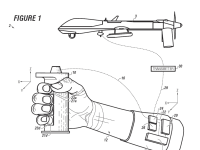Do you remember when you were young and wanted to fly an airplane? Do you remember flying with your hand? Twisting your wrist to climb and dive, bank and turn? It was so easy to feel yourself in a cockpit, zipping through the clouds. What if you could do that for real?
Consider a hand-held device that isolates and captures 3-axis wrist motion to control an aircraft. The control is natural and intuitive. Unlike the mental and physical translation needed to use conventional joystick controllers, the Manus controller is immediately obvious to the novice. And, it reduces the expert's cognitive workload. This is in no small part because the wrist's motion closely mimics an aircraft's three rotational degrees of freedom. Although there are other devices that perform a similar function, none are as simple to use, as compact, as broadly applicable, or as compatible with existing infrastructure.
Manus, a patented device [1] (see Figure 1), was originally conceived as an after-market add-on for radio control model aircraft; it plugs into a radio control transmitter's standard interface. When the concept was presented at the inventor's model airplane club, other modelers wanted to try it right away. Hobbyists are the device's first market target; and that market is substantial. In the USA, the Academy of Model Aeronautics [2,3] boasts 195,000 members in 2400 clubs; 57,000 of those members are less than 20 years old. In addition, the Federal Aviation Administration [4] has certified 231,457 remote pilots. These numbers describe the hobbyist and commercial aircraft market; there is also a military market. However, aircraft are just one application. Manus can control any object that moves in one or more dimensions: a submarine, a remote camera, a stealthy reconnaissance vehicle, a robotic arm, a wheelchair driven across the room to its waiting user, or a user's point-of-view in a 3D simulation.
The Manus version presented at the 2015 Embedded Systems Conference uses a microprocessor and two differential 6-DOF inertial measurement units (IMU) to capture wrist position and to counter the effects of the Parallel Axis Theorem. Custom software controls the user interface and processes IMU input; e.g., Figure 2 shows the result of one signal filtering simulation. There are other Manus versions; however, they all use commercial-off-the shelf (COTS) components and straightforward manufacturing techniques. Manufacturing simplicity is important because the device will be assembled in urban and rural areas that do not normally host hi-tech industries.
[1] https://patentimages.storage.googleapis.com/08/15/f6/af0c4213f7734d/US9804595.pdf
[2] https://en.wikipedia.org/wiki/Academy_of_Model_Aeronautics
[3] https://www.modelaircraft.org/sites/default/files/memanual.pdf
[4] https://www.faa.gov/uas/resources/by_the_numbers/
Voting
-
ABOUT THE ENTRANT
- Name:Samuel Denard
- Type of entry:individual
- Profession:
- Samuel is inspired by:When I was young, a wise old man took me aside and said, "If you see something that needs doing, do it. If it's worth doing, it's worth doing well. And, do it cheerfully!" Designing things, building things, and trying to understand things are worth doing because they bring a little light into this world. When I can manage to do them well, maybe other people will be able to see their way a bit more clearly. And, it is certainly easy to be cheerful about that. That old man is long gone; I wish he could see that I heard him. Each day, I try to honor his advice and his willingness to share it with me.
- Software used for this entry:custom software; Microsoft and Microchip development tools
- Patent status:patented





